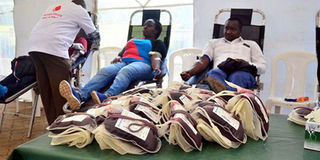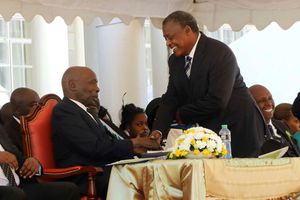Premium
Why national blood transfusion service needs a shot in the arm

Kenya National Blood Transfusion Services runs a blood donation drive at Kenya National Archives in Nairobi on September 11, 2019. The blood bank is running low. PHOTO | FILE | NATION MEDIA GROUP
What you need to know:
- The US funded the service to the tune of Sh850 million a year through the US Pepfar and the Centers for Disease Control and Prevention, Kenya.
- However, the funding would only go for 17 years as the Kenyan government, through the Ministry of Health, was meant to take over after that.
Somewhere in the vast complex that is the Kenyatta National Hospital grounds is a quiet little building, its modern fixtures and accessories completely at odds with its rather dilapidated surroundings. This is the headquarters of the little-known Kenya National Blood Transfusion Services (KNBTS).
Inside, it feels like an oasis of peace, calm, sunshine and happiness. The quiet belies the bloody mess going on inside.
Kenya is in the thick of a blood crisis. Blood stocks have been running unusually low since mid-last year, and now we’re at a critical level.
If you are on social media, you have probably seen tweets and posts asking the public to donate blood for particular patients at various hospitals.
What you may not know is that hospitals are not allowed to collect or test their own blood; the KNBTS is exclusively tasked by the government to regularly collect, test, match and distribute blood and blood products – at no cost to patients.
Cancer patients suffering chemotherapy-related anaemia need transfusions.
WHEN IN NEED....
Pregnant women suffering post-partum haemorrhage (the leading cause of maternal deaths) need them. Accident victims need them.
Surgery patients need them. Malaria patients sometimes need them. You might not be a pregnant woman or anaemic, but a serious car accident or even a vicious bar fight can put you in need.
The effects of the shortage are already beginning to bite. In August last year, an expectant 18-year-old woman from Dol Dol, Laikipia County, went to the local hospital to deliver.
She suffered 14 hours of labour. When she started losing blood, the maternity wing doctor-on-call decided not to admit her for an emergency Caesarean section because they could not find blood.
Dr Lenai Kamario, the county executive for Health in Laikipia, says the hospital decided to transfer her to Nanyuki Teaching and Referral Hospital.
She was also denied admission there for the same reason. Two other private facilities also rejected her. The team eventually had to look to a neighbouring county for help.
MAN-MADE SHORTAGE
Thus, what the young mother believed would be an easy birth turned out to be a journey of about 119 kilometres, all the way to the Nyeri County Referral Hospital, where she ended up losing the baby and had to recover from severe tears to her birth canal.
The blood shortage is not limited to county hospitals in far-flung townships. It is countrywide.
Our current national demand stands at 500,000 units per year. However, KNBTS blood collection has stood at around 150,000 to 200,000 units a year.
Daily demand should stand at 1,100 units but, at the moment, it is up to 2,000 units. There really is no reason for the shortage.
Everyone has blood in their veins. In a country of 47.5 million people, we can assume that half – 23.8 million – are eligible to donate at least one pint of blood each per year.
If we were to knock out half of eligible citizens for various reasons, such as disease or weakness, there would still be in excess of 10 million pints available for storage.
And even if we only reduced that to a quarter of the total Kenyan population, that would yield at least five million pints.
DONATION APPEAL
The persistent blood shortage has given rise to a number of complicated scenarios. Hospitals are now forced to ask sick patients to summon friends and relatives to donate blood for them.
“Blood donors should be voluntary and non-paid,” says Dr Peter Mwamba, a haematologist, lecturer at the University of Nairobi, and a consultant for Kenyatta National Hospital.
According to the World Health Organisation, healthy, regular donors who know they don’t have HIV, hepatitis B, or C, or syphilis provide better quality blood than friends and relatives showing up at hospitals to donate out of guilt or love for their sick one.
In addition, hospitals charge for collection, testing and transfusion. And while many large private hospitals are expected to have qualified personnel and equipment to accurately screen donor blood, smaller, less flush hospitals cannot offer the same guarantee.
Veteran journalist Washington Akumu found himself in a desperate situation despite the fact he had been admitted at one of Kenya’s top private hospitals.
Mr Akumu had gone in for surgery to remove a tumour in his right kidney. It was to be a three-hour procedure at Nairobi Hospital.
INADEQUATE SUPPLIES
It turned into an eight-hour battle for his life, and all because of the blood shortage. “I needed 22 pints of blood and 18 platelets. My family had to call on people from as far as Kisumu to donate blood,” he says.
While he did not pay for the blood, he had to pay for transfusion services, which include storage in sterile blood bags, testing and screening for various diseases, as well as delivery to the hospital.
Philip Ogola, founder of the Digital Humanitarian Service, which regularly organises blood drives, says not a week goes by without him having to tweet blood donation appeals.
“What most Kenyans don’t know is that they have a right to ask hospitals to get blood from the KNBTS for free and yet many end up paying for it,” he says.
A pint of blood costs anywhere between Sh10,000 and Sh19,000 to process, and many hospitals will charge a Sh3,000 additional fee.
“As things stand, we are running very low on supplies – no blood bags, no reagents (for our automated machines), gloves or refreshments,” say staff members who spoke to the Saturday Nation on condition of anonymity for fear of repercussions.
The main cold room at the Nairobi region BTS is not working; staff store available blood units in small fridges.
“Right now this is not a problem because we don’t have a lot of blood,” says the staff member.
US FUNDING
In addition, where there is blood, there is no money to fuel vehicles to transport them, and neither are there drivers.
Part of this the problem is the withdrawal of donor funds that sustained up to 80 per cent of the KNBTS operations, including support staff such as drivers and IT staff.
The US government set up the blood bank after the 1998 US Embassy bomb blast in Nairobi, with specially trained staff who would be in charge of assuring the quality of donor blood in the country.
Besides the head office at Kenyatta National Hospital, there are five regional centres in Mombasa, Kisumu, Eldoret, Embu and Nakuru and 22 satellite centres spread around the country.
The US funded the service to the tune of Sh850 million a year through the US President's Emergency Plan for Aids Relief (Pepfar) and the Centers for Disease Control and Prevention (CDC), Kenya.
However, the funding would only go for 17 years as the Kenyan government, through the Ministry of Health, was meant to take over after that.
The funding was reduced on a five-year basis. Then in July last year, the funding ceased altogether, catching the Ministry of Health apparently unaware, despite the fact that the withdrawal of funding was always part of the initial design of the project.
“The current problem is a lack of planning on the part of the Ministry of Health,” says Joseph Wang’endo, who runs Bloodlink Foundation, a KNBTS partner.
INVESTIGATIONS
Partners are in charge of mobilising the public to attend blood drives, and there are two other official ones – Hope Worldwide Kenya and the Kenya Red Cross Society. Partners, however, do not collect or handle blood, as this is exclusively KNBTS territory.
“The Ministry knew the funding was coming to an end. They just didn’t prepare for it,” adds Mr Wang’endo.
Last year, Health Cabinet Secretary Sicily Kariuki addressed the crisis, saying the ministry had enough resources to ensure sufficient blood supply countrywide, and promised to investigate the reasons for the shortage, but she did not respond to the Saturday Nation’s query as to whether the problem had been pinpointed.




